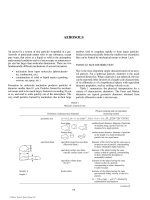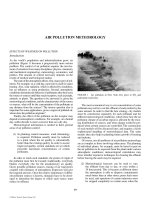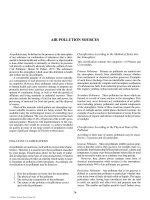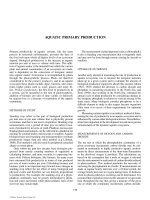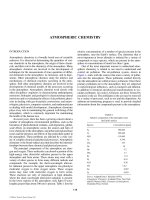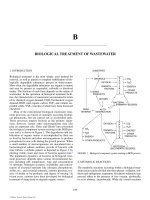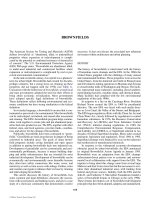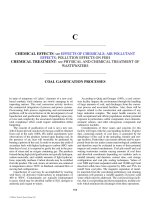ENCYCLOPEDIA OF ENVIRONMENTAL SCIENCE AND ENGINEERING - PREVENTION OF TOXIC CHEMICAL RELEASE doc
Bạn đang xem bản rút gọn của tài liệu. Xem và tải ngay bản đầy đủ của tài liệu tại đây (491.8 KB, 6 trang )
1022
PREVENTION OF TOXIC CHEMICAL RELEASE
Purging of process vessels, tanks and piping before startup
and after shutdown is imperative for pilot plants and large-
scale plants in the process industries or wherever combusti-
ble gases and vapors are handled. Gases most often used for
purging are nitrogen, carbon dioxide, or gases derived from
the combustion of hydrocarbons. The reader is referred to
the sections on Vapor and Gaseous Pollutant Fundamentals
and to Fossil Fuel Cleaning for unit operations and incinera-
tion procedures involved in hazardous gas removal. To show
how the purging procedure can be “mapped” a typical purg-
ing chart will be constructed and the salient points explained
(see Appendix).
Inert gases such as nitrogen have the property of not only
depressing or narrowing the explosive range of a combus-
tible gas or vapor, but also of preventing the formation of
explosive mixtures with air when these inert gases are mixed
in suitable proportions with either air or with the combus-
tible gas or with an explosive mixture of both. By displacing
or mixing air contained in a vessel, tank or piping system to
be placed into gas service, with a suitable amount of an inert
gas such as nitrogen, a combustible gas may subsequently
be introduced without the formation of an explosive mix-
ture. Similarly, by displacing or mixing the combustible with
a suitable amount of nitrogen, air may later be introduced
without causing an explosive mixture to develop. During
the purging procedure constant sampling of contents must
be pursued using standard accepted methods of chemical
analysis.
GAS FLAMMABILITY LIMITS
A flammable mixture of a gas, such as acetylene and air, may
be diluted with one of the constituents (acetylene or air) until
it no longer is flammable. The limit of flammability due to
dilution is the borderline composition: a slight change in the
direction will support burning, while in the other direction
combustion cannot be supported and maintained.
At the ends of these two extremes there are well defined
limits within which self-propagation of flame will take place
on ignition. These are known as “upper” and “lower” limits
as defined in terms of the percentage by volume of com-
bustible gas present in a mixture of the gas and air. Table 1
below lists these limits for some of the more common gases
and vapors for conditions of atmospheric pressure and
temperature.
Within these limits, the combustible gas and air mix-
ture liberates sufficient energy to continue to propagate
flame from one mixture layer to the other. Mixtures above
the upper limit may burn on contact with external air, since
these layers are formed in the zone where gases mix. Certain
conditions effect a shift in the two limits, either increasing
or decreasing the spread between them as we will note later.
These conditions include: ignition source, ignition inten-
sity, direction of flame propagation (upward, downward, or
across), size and shape of container, vessel, or piping orien-
tation, temperature, pressure and humidity in the containing
vessel, oxygen content and turbulence.
EXPLOSIONS
When a chemical reaction is accompanied by the libera-
tion of heat, as the reaction progresses, it is followed by an
increase in the amount of heat, which in turn helps to accel-
erate the reaction. Thus the two advance together, both in
highly intimate connection and mutually helpful, until the
entire mass has been heated and chemically converted.
When a burning substance, a match for instance, is placed
in contact with the extreme outer limit of an explosive mix-
TABLE 1
Per cent gas or vapor in mixture—flammability limits
Gas or
vapor Lower Upper
Gas or
vapor Lower Upper
Acetylene 2.5 80.0
Carbon monoxide 12.5 74.2 Acetone 2.6 12.8
Hydrogen 4.0 74.2 Ethane 3.2 12.5
Ethyl ether 1.9 48.5 Propane 2.4 9.5
Carburetted 6.4 47.7 Butane 1.9 8.4
Hydrogen sulfide 4.3 45.5 Benzene 1.4 8.8
Methyl alcohol 6.7 36.5 Gasoline 1.5 6.2
Coal gas 3.9 29.9 Turpentine 0.8 —
Ethylene 2.8 28.6 Ammonia 16.0 27.0
Pennsylvania 4.9 14.1 Ethyl alcohol 3.3 19.0
Natural gas — — Methane 5.0 15.0
Reference: G. W. Jones, Chemical review Vol. 22, 1938. pp. 1–26.
C016_011_r03.indd 1022C016_011_r03.indd 1022 11/18/2005 1:12:55 PM11/18/2005 1:12:55 P
© 2006 by Taylor & Francis Group, LLC
PREVENTION OF TOXIC CHEMICAL RELEASE 1023
ture of gas and air, ignition takes place at the point of contact,
i.e. incites chemical reaction. Combustion proceeds from the
outside of the mixture towards the center, and thereby forms
a plane of combustion which divides the gaseous mixture
into two parts. On the one side are the highly heated products
of combustion, and on the other, is the still unconsumed gas
mixture.
The velocity at which this plane advances in different
for each gaseous mixture, and depends both on the compo-
sition of the mixture and on the pressure to which it is sub-
jected. The higher the velocity of propagation the greater
the rise in temperature, and this latter, in turn, directly influ-
ences gas expansion and the products of combustion, which
thereby exert such a high pressure on their environment that
any opposing medium, vessels, tanks, piping, walls, etc. is
ruptured.
APPLICABLE EXPLOSIBILITY DATA
Not all explosibility data reported in the literature are appli-
cable to purging problems. From the safety standpoint, it is
desirable to select the widest explosive limits for the purge
operation. In addition, an ample safety factor be applied,
especially to the lower explosive limit. For acetylene-air
mixtures, at atmospheric pressure and temperature, the
published and accepted values for the lower explosive limit
(LEL) and upper explosive limit (UEL) are 2.5 and 80.0%
acetylene in air respectively. These are the widest limits
recording. See Table 1.
In every case involving combustible gas handling or
processing, constant awareness of the inherent dangers to
life and limb as well as property is imperative. In the case
of acetylene, it is a well known fact that it has unstable
characteristic at any pressure and whether or not a decom-
position would take place depends on the intensity of
the initial source of ignition. Higher pressures have the
effect of lowering the initial energy necessary to initiate a
decomposition.
ACETYLENE—CASE STUDY
Acetylene is inherently an unstable gas at any pressure and
whether or not a decomposition would take place depends
on the intensity of the initial source of ignition. Higher pres-
sures have the effect of lowering the initial energy necessary
to start a decomposition. Higher initial pressures will also
result in an increase in the ratio of the maximum pressure
developed in the decomposition to the initial pressure. As
for acetylene-air mixtures, pretty much the same behavior
is manifested. With decreasing ignition energies, the initial
pressures must be correspondingly increased so as to bring
the total gas mixture volume to decomposition.
The size, shape and orientation of a process vessel as
well as its material of construction have a profound effect
on the ignition limits of combustible gas mixtures. The same
applies to acetylene decompositions. It is a matter of heat
balance during the combustion process. Even the relative
position of the source of ignition. The widest explosive range
is obtained for vertical cylindrical vessels or tanks when the
ignition source is located at its base.
The presence of water vapor and high humidity acts as a
diluent and an inert gas. This effect is typical for all combus-
tible gas–air mixtures.
As for the effect on explosion limits, the ratio of vessel
surface to cross-sectional area from a cooling or heat bal-
ance point of view, long slender vessels (high ratio of surface
to sectional area) narrow the limits of explosibility. It’s all a
matter of the rate at which heat is removed from the gas mix-
ture inside the vessel. As for the temperature effect, higher
temperatures induce convection currents within the vessel
and increase turbulence and widen the limits.
Thus, only tests of actual operating setups can tell the
effects on the widening or narrowing of the explosibility
range. Then, once established, the LEL and UEL determined
experimentally can be used to develop a purging graph here-
inafter discussed and developed.
EFFECT OF INERT GAS
The effect of an inert gas on explosibility of combustible gases
in air can be shown graphically on Figure 1 for acetylene–
air mixtures. Once the conditions for actual operating condi-
tions and configuration are determined experimentally, the
graph can be set up as we shall see.
As nitrogen is added to mixtures of the gas and air within
the explosive range, a series of new mixtures are formed
each of which has a different UEL and LEL than the pre-
ceding mixture and the explosive range is narrowed along
definite lines of demarcation. As the air and combustible gas
contents are reduced by the addition of nitrogen, the line of
LELs and the line of UELs converge and meet at a point,
i.e., D. Here the range has degenerated to zero. No mixture
of acetylene, air and nitrogen which contains less oxygen
than the lowest point on the line LDU (point D ) is explosive
in itself, but all mixtures within the areas bound by LUD are
within the limits of explosibility and are therefore explosive.
Again, in Figure 1, line ADE is drawn tangent to LDU at D.
Any mixture represented by point X to the right of line DE
and below the upper explosive limits DU is not explosive in
itself. However, on dilution of that mixture with air, a new
series of mixtures will be formed having compositions fall-
ing along line X A which passes through the explosive area.
Similarly, any mixture represented by a point to the left of
line LD and DE will not form explosive mixtures on further
dilution with air.
Note line LD is not vertical but swings to the right
as falls.
APPLICATION OF GRAPH
At startup when placing gas equipment into service purg-
ing from air to inert gas, the object is to reduce the oxygen
C016_011_r03.indd 1023C016_011_r03.indd 1023 11/18/2005 1:12:55 PM11/18/2005 1:12:55 P
© 2006 by Taylor & Francis Group, LLC
1024 PREVENTION OF TOXIC CHEMICAL RELEASE
100
90
80
70
60
50
40
30
20
10
0
z
100
90
80
70
60
50
40
30
20
10
0
Z
Y
X
100
90
80
70 60
50
40
30
20
10
0
10 20
30
40
50
60
70
80
90
100
20
18
16
14
12
10
8
6
4
2
0
F
D
B
E
21
97.5 %
Y
START
(LEL)
A
Combustible gas (Acetylene per cent by Volume)
Inert gas (Nitrogen) per cent by Volume
(Taking Equipment out of Service)
X
START
(LEL)
Line of LEL’S
C
20%
Lower Limit 2.5 % C
2
H
2
pure and dry
97.5% air dry
0% N
2
inert added
Line of flammability
limits from Fig.1
C
2
H
2
and air only
zero inerting
nitrogen
Explosion (2)
range
narrowed
on
addition of
nitrogen
Line of UEL’s
Upper Limit 80% C
2
H
2
pure and dry
20% Air dry
0% N
2
inert added
2.5
4.8
Inert Gas (Nitrogen) per cent by Volume
(Putting Equipment into Service)
Air per cent by Volume
(Equivalents)
Oxygen equivalent in air per cent by Volume
(1)
FIGURE 1 Acetylene-Air-Nitrogen purging chart (atmospheric temperature and pressure).
C016_011_r03.indd 1024C016_011_r03.indd 1024 11/18/2005 1:12:55 PM11/18/2005 1:12:55 P
© 2006 by Taylor & Francis Group, LLC
PREVENTION OF TOXIC CHEMICAL RELEASE 1025
content of the air inside the equipment to a point that acety-
lene (or other gas) may be subsequently introduced with-
out forming an explosive mixture. From Figure 1 it may
be observed that the safe condition will be reached when
the oxygen content within the vessel or equipment has been
reduced by the introduction of nitrogen to below approxi-
mately 6.6% by volume, point F where FC drawn tangent
to LDU at D intersects the vertical axis AB. Any mixture
of this combustible gas, nitrogen and air having an oxygen
content represented by a point below this line FC may be
diluted with the combustible gas without forming an explo-
sive mixture (see Appendix).
WHEN SHUTTING DOWN
Likewise, when shutting down or withdrawing equipment
containing acetylene from service or when purging from
combustible to inert gas, the object is to reduce combustible
gas content to such a point that the air may subsequently
be introduced without fear of forming an explosive mixture.
Figure 1 shows that a safe condition will be reached when
the combustible gas content within the equipment or piping
has been reduced to below 4.8% by volume, denoted by
point E.
On occasions the mixtures of acetylene, nitrogen and air
are to be diluted with a further quantity of inert gas so as to
render them nonexplosive or incapable of forming explosive
mixtures on later addition of air. Object here is to add suf-
ficient nitrogen to convert the existing composition of the
mixture to some composition corresponding to a point to the
left of LD and DE. If we assume that the mixture is again
denoted by point X , then on addition of nitrogen, successive
mixtures will be formed along XB. Point where XB crosses
DE denotes the safe endpoint composition. Then on the fur-
ther addition of air (intentional or accidental) the line of mix-
tures will fall to the left of LDE.
In practice, it is desirable to decrease the proportions of
oxygen and combustible gas below the determined values to
provide a factor of safety. To prevent explosion in chemical
processing, it is necessary to keep the air–gas or–vapor or
mixture of the gases, air and nitrogen, below the LEL within
the equipment most likely to be affected. An established safe
practice is to keep the mixture well blended with air or inert
gas so that calculated or experimental values never reach
more than 25% of the LEL or other low limit as determined
from Table 1 in temperatures below 250°F. Placing system
into service or out of service should be done when system
has been depressurized to atmospheric pressure.
DEPRESSURIZING TO ATMOSPHERE
More often than not, combustible-gas releases to atmosphere
do not contain air. When handling acetylene in its pure
state a maximum pressure of 15 psig is usually used. Thus
on release to atmosphere large quantities of the gas may
be emitted through pressure relief valves to flares or high
stacks. Then again the gas may be returned to gas holder
storage. If released to atmosphere, inert gas purging should
be provided. An excellent reference on inert-gas purges of
stacks on pressure releasing has been published
*
; for process
equipment see review.
12
SAMPLING OF MIXTURE CONTENTS
During startup or shutdown of systems, sampling of mix-
tures within equipment should be conducted downstream of
the point of injection of nitrogen to ensure proper mixing
of gases before sampling. Taking samples from stratified
streams should be avoided. For piping systems sampling
should be taken downstream of elbows and open valves. In
anticipation of this elbows and turns as well as valves should
be designed into the system originally. In actual testing it has
been observed that form 6 to 10 volume changes are neces-
sary to purge equipment or piping systems. Sampling should
begin after this purge.
Purging to a point below the LEL may be done using
an explosimeter
†
that has been properly calibrated for the
gas–air–nitrogen mixture. Laboratory testing procedures
may also be used where samples are washed
†
with acetone
and the volume of acetylene absorbed deducted from the
entire sample to give volume of the remainder gases as air
or nitrogen.
Spark-resisting tools should be used to prevent sparking
and possible ignition of combustible gas. Work shoes with
rubber soles and so steel studs should be used. In addition,
continuous sampling of the workroom atmosphere should be
conducted using explosimeters built for that purpose.
INERT GAS SUPPLY
Where rigid purity of inerting gas is not a requirement, the
use of inert gases obtained from the combustion of hydrocar-
bon fuels may be used. This decision is one to be based on
experience and processing needs.
Gas analysis can now be accurately measured and con-
trolled in tenths of a percent range. These inert gas genera-
tors are provided with rugged instrumentation and controls
for hazardous environments as found in desert and offshore
installations. The analysis can even be accurately measured
down to the ppm range where instrumentation maintenance
is present. The same caliber of technician is needed whether
or not the nitrogen source is cryogenic or hydrocarbon.
Such inert gas generators are currently supplied with
automatic trimmer control which analyzes the discharge gas
and automatically controls the air-to-fuel ratio. For critical
installations they are even equipped with inexpensive auto-
matic vent and alarm systems. For more information and
their technical manual, write to C.M. Kemp Manufacturing
Company, Glen Burnie, Maryland 21061.
†
Explosimeters are available from Mine Safety Appliances
Company, Pittsburgh, PA 15235 and Davis Emergency Equipment
Company, Newark, New Jersey.
C016_011_r03.indd 1025C016_011_r03.indd 1025 11/18/2005 1:12:55 PM11/18/2005 1:12:55 P
© 2006 by Taylor & Francis Group, LLC
1026 PREVENTION OF TOXIC CHEMICAL RELEASE
Skid-mounted units for applications in remote loca-
tions, or where onsite cryogenic facilities are too large to
be cost-effective, are available. These units provide nitro-
gen at purities of 97 to 99.5%. They operate by pressure-
swing absorption, in which a bed of activated carbon absorbs
oxygen from air at high pressure and desorbs it at reduced
pressure. The nitrogen produced by this cyclic process con-
tains 5 ppm of water and CO
2
. 400 to 20,000 cfh of nitro-
gen can be supplied, at a pressure of 100 psig. Write Airco
Industrial Gases, Murray Hill, New Jersey.
Nitrogen for purging may also be supplied from cas-
cade systems or directly from “bottle” trailers under pres-
sure, normally 2000 psig. When drawn from large cascade
systems or reservoirs the nitrogen is piped into a “running
tank.” The “run” tank is then pressurized and its contents are
expanded through pressure regulators as desired for purging.
When pressurized trailers are used, the high pressure gas is
regulated down to the desired pressure for purging.
ACKNOWLEDGMENTS
This article appeared in its original form in Chemical
Engineering, December 9, 1980, pp. 65–68. It has now been
redone to provide more useful detail in the designation and
use of the chart. A special section on checking points and
areas on the graph has been included. This author grate-
fully acknowledges with thanks the permission by Chemical
Engineering to update and republish.
APPENDIX
STEPS IN SETTING UP PURGING CHART
1) Draw right triangle ABC whose size is to accom-
modate ordinate and abscissa scales.
2) Fill in both ordinate and abscissa scales for the
combustible of concern.
3) From Table 1 superimpose the explosive range of
the combustible gas of concern on line AC, using
the abscissa scale values.
4) Using the experimentally determined value equiv-
alent of point, E , strike that value on line BC.
5) Draw line AE.
6) Draw lines LD and UD.
7) Draw line FDC.
8) Establish any point X below line FDC.
9) Draw lines AX and BX as shown.
10) Complete the chart by adding in the notes and
other embellishments.
Draw chart carefully so that the various points can be
determined with accuracy. And remember to use a safety
factor in applying the chart figures, i.e. 25% of the chart
values (points E and F) when taking equipment out of ser-
vice and when putting equipment into service, respectively.
PURGING CHART DESIGNATIONS AND USE
Point D ϭ No mixture of acetylene, air, and nitrogen which
contains less than 6.4% oxygen is explosive.
LDU ϭ All mixtures within area of triangle LDU are
explosive.
Point X ϭ Any mixture such as denoted by point X is not
explosive.
Line XA ϭ On dilution of mixture denoted by point X with
air, new mixtures along XA are formed.
LDE ϭ Any point to the left of LDE will not form
explosive mixtures on dilution with air.
FDC ϭ Any mixture of acetylene, nitrogen and air rep-
resented by a point below FDC may be diluted
with acetylene without forming an explosive
mixture when placing equipment into service.
Point F ϭ fe point reached after air displaced with nitro-
gen and ready to add acetylene (6.6% oxygen)
when placing equipment into service.
Point E ϭ Safe point reached after acetylene displaced with
nitrogen and ready to add air (4.8% acetylene).
This is the situation when taking equipment out
of service.
CHECKING POINT AND AREAS ON GRAPH
Purpose is to become better acquainted with the graph and to
check various points.
UEL From UEL on AC read down vertically to 80% acety-
lene on BC. Then read horizontally left to YY and read 20%
air by volume, with Zero inert nitrogen. Then by calculation
and since composition of air is 21% oxygen and 79% nitro-
gen by volume: O
2
ϭ 4.2%; N
2
ϭ 15.8%.
LEL Likewise: 2.5% acetylene and 97.5% air and zero
inerting nitrogen. In the air: 20.48% O
2
and 77.02 N
2
%.
Point 1 This lies within area bound by LDU and should be
explosive. Now from point 1 drop vertically and read 30%
acetylene on BC. Move horizontally left to YY and read
air per cent ϭ 4.6. Then by calculation, O
2
content in air ϭ
9.66% and nitrogen content ϭ 36.34%. By difference inert-
ing nitrogen is 70–46 ϭ 24% by volume. Since 9.66% O
2
is
greater than 6.4%, the mixture is explosive.
Point X Should not be explosive. From X drop vertically
and read 21.5% acetylene as before. Move horizontally left
and read 19% air on YY. Then by calculation find O
2
in air ϭ
3.99% and N
2
in air ϭ 15.01%, leaving 59.5% inerting nitro-
gen by volume. Since O
2
ϭ 3.99% and is less than critical
value of 6.4%, mixture is not explosive.
Point 2 Should be explosive. Acetylene ϭ 30%, air ϭ 70%.
O
2
ϭ 14.7% and nitrogen ϭ 53.3%. Zero inerting nitrogen.
Now since O
2
is greater than 6.4%, mixture is explosive.
C016_011_r03.indd 1026C016_011_r03.indd 1026 11/18/2005 1:12:56 PM11/18/2005 1:12:56 P
© 2006 by Taylor & Francis Group, LLC
PREVENTION OF TOXIC CHEMICAL RELEASE 1027
X A line and UEL line intersect Acetylene ϭ 19%, air ϭ 29%,
O
2
ϭ 6.09%, 52% inserting nitrogen. This is a borderline case
and safely assume nitrogen is explosive. Dilute with acetylene
of nitrogen to render mixture non-explosive.
XB On dilution of mixture X with nitrogen, new mixture
will fall along XB and remain non-explosive. In this process,
per cent O
2
will continue to drop below 6.4%. Dilution with
acetylene would effect the same results.
When shutting down Add N
2
until acetylene reaches 25%
of experimentally determined lower limit. Thus, 0.25 ϫ
4.8 ϭ 1.2%.
When starting up Add N
2
until O
2
reaches 0.25 ϫ 6.4 ϭ
1.6%. When purging with any gas allow from 6 to 10 volume
space changes before testing for concentrations. The Design
Institute for Emergency Relief Systems (DIERS) Users
Group, which is an affiliate of the American Institute of
Chemical Engineers, has developed some methodology to
design emergency relief systems.
8
The DIERS study was
very extensive and complicated. It involved significant devel-
opments and applications of complex theories and experi-
ments. Some aspects were reaction kinetics under runaway
conditions and multiphase critical flashing flow for viscous
and nonviscous systems. A number of DIERS users have
attempted to simplify the DIERS technology.
9,10,11
REFERENCES
1. Prevention of Acetylene–Air Explosions by Addition of Carbon Dioxide
or Nitrogen. Dr. W. Gliewitzky, Berlin Autogene Metall bearbeitung,
1940, No. 1, 2–5.
2. Bureau of Mines Bulletin 279 (1938). Limits of Inflammability of Gases
and Vapors. H.F. Coward and G. W. Jones.
3. Theoretical and Practical Considerations in Purging Practices.
S. S. Tomkins, A.G.A. Proceedings (1934), pp. 799–828.
4. Precautions in High Pressure Acetylene Work. B.I.O.S. Final Report
No. 1162. Item No. 22, London—H.M. Stationary Office. S.O. Code
No. 51–1275–62. Tests conducted during years 1940, 1941 and
1944.
5. Industrial Explosion Prevention and Protection, Bodurtha, Frank T.,
Engineering Department, E.I. du Pont de Nemours & Company, Inc.,
1st Ed. 1980, McGraw-Hill Book Company, New York City.
6. Kemp Gas Generator Technical Manual, The C.M. Kemp Manufac-
turing Company, Engineered Gas Systems Division, Glen Burnie,
Maryland 21061.
7. Gascope Combustible Gas Indicator, Models 60 and 62, Mine Safety
Appliances Company, 600 Penn Center Boulevard, Pittsburgh, PA
15235.
8. H.G. Fisher. DIERS Research Program on Emergency Relief Systems.
Chem. Engr. Prog., 81 (8), 33–36 (August 1985).
9. H.K. Fauske, G.H. Clare, and M.J. Creed. Laboratory Tool for
Characterizing Chemical Systems. Proceedings of the International
Symposium on Runaway Reactions, Cambridge, MA, March 7–9,
1989. Center for Chemical Process Safety/AIChE, New York, 1989,
pp. 372–394.
10. J.A. Noronha, R.J. Seyler, and A.J. Torres, Simplified Chemical and
Equipment Screening for Emergency Venting Safety Reviews Based on
the DIERS Technology. Proceedings of the International Symposium
on Runaway Reactions, Cambridge, MA, March 7–9, 1989. Center for
Chemical Process Safety/AIChE, New York, 1989, pp. 660–680.
11. D.P. Mason. Highlights of FM Inspection Guidelines on Emergency
Relief Systems. Proceedings of the International Symposium on Run-
away Reactions, Cambridge, MA, March 7–9, 1989. Center for Chemi-
cal Process Safety/AIChE, New York, 1989, pp. 722–750.
12. Chatvathi, Kris, and Richard Siwek. Suppression Systems Mitigate
Explosions, Chem. Eng. Prog. Vol. 92, March 1996.
JOHN D. CONSTANCE (DECEASED)
Consultant, Cliffside Park, N.J.
C016_011_r03.indd 1027C016_011_r03.indd 1027 11/18/2005 1:12:56 PM11/18/2005 1:12:56 P
© 2006 by Taylor & Francis Group, LLC

